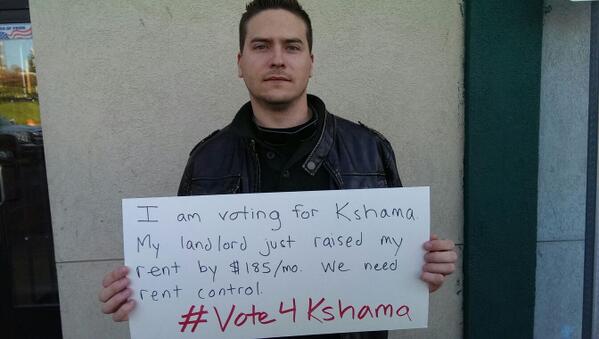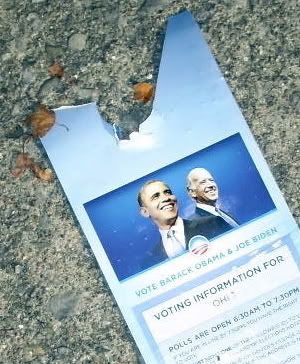While the attention of most American journalists and politigeeks on Tuesday was justifiably focused on the state-level races in Virginia and New Jersey, there was an array of other state and local elections in the US too, including mayoral elections in range of major cities. Even further down into the weeds, however, was an unlikely feature.
Socialists.
Real, dyed-in-the-wool, third-party revolutionary socialists, almost winning office in major cities. When’s the last time that happened? Sixty years ago?
In Seattle, a Socialist called Kshama Sawant came very close to winning a city council seat, getting 47.6% of the vote (some 56 thousand of ’em) in the race for City of Seattle Council Position No. 2. In the lead, as the counting of mail-in ballots continues, is a Democrat, Richard Conlin, but right now he’s winning it with just 52.2% of the vote. The margin (which was 53.6% vs 46.1% on election night) has been somewhat narrowing since as mail-in ballots that were sent in closer to the election are counted, and Sawant has not conceded yet. [Update, Nov. 7: Sawant is now up to 48.3% and some 62 thousand vote, and her campaign is actually claiming that “victory is within reach”.] [Update 2, Nov.12: Eight days after the elections took place, with the counting process still continuing, Kshama Sawant has for the first time actually pulled into a lead. Even if it’s the narrowest of leads. The tally is now: Sawant with 49.91% – 79751 votes; Conlin: with 49.88% – 79710 votes. The counting isn’t done yet; the vote won’t be certified until Nov. 26. But this is an impressive feat – and a crazy race.]
In Minneapolis, a Socialist called Ty Moore received 37.5% of the vote in the elections for a city council seat there. It was a much smaller race, though, with Moore getting 1,565 votes. Democrat Alondra Cano is ahead in that race, having received 40.7% of the vote (1,696 votes). Since neither won over 50% of the vote, this means nobody was elected yet, though Cano looks best positioned to win it.
These are not some kind of Francois Hollande-type ‘Socialists’ either. These are revolutionary socialists, affiliated to a Trotskyite party. They mean it, man.
In Seattle, the Democrat who did win the seat [or did he? See update above], Richard Conlin, is apparently pretty progressive himself – a local station calls him “a darling of the Democratic party with left-leaning views”. Which makes it all the more surprising/impressive that Sawant got as far as she did. According to the city’s archivist, no socialist ever was this close to winning a city council position in Seattle – even including the halcyon days when Eugene Debs won 10%+ in the Western states (and over 20% in Snohomish County, next door to Seattle).
No wonder, maybe, that it’s not just those who actively supported her, but more neutral observers too, who argue that she might have won even if she loses. A sitting councilman quoted in the KUOW link above remarked that “My hope is that she doesn’t disappear after the election if she loses; she represents the poor, the immigrants, the refugees – the folks who are not in our City Council offices lobbying us.”
In Minneapolis, officially the race is still open. Instead of organizing a second round election, in the city’s Australian-style system of instant-runoff voting the vote counters will now redistribute the votes for each of the minor candidates who pooled the remainder of the votes, according to the second preferences indicated by their voters. And they’ll keep doing that until one of the frontrunners hits a majority.
Since all but one of the also-rans were Democrats, however, I guess that makes it likely that Cano will win. The exception is a progressive-sounding candidate running under a “Politics with Principle” label – there was no Republican in the race – and he received 8% of the vote. But if his voters were perhaps inclined to give Ty Moore their second preference, they will in turn probably be outweighed by those of Abdi Abdulle, who received 7% of the vote and whose website touts Cano’s recommendation to give Abdulle second preference votes. I assume it would be hard to guess where voters go since Cano is no conservadem either, even if she was endorsed by the local Start Tribune for being “the pragmatist” in the field; she presents herself as a union-endorsed progressive.
We will know soon enough – right now, the city is retabulating the mayoral election results, and Moore’s Ward 9 will be the second race being tallied up in full after that. (Update: retabulating the results of the 35 candidates who took part in the mayoral election took so much time, work on the remaining races will be continued on Friday.) But considering that Cano has more second preferences as well as first choices than Ty Moore, there would have to be some kind of very lopsided proportions in how the voters of the two candidates exchanged second preferences for each other’s candidate for Moore to pull it out.
[Update: The second and third preferences of the also-rans have now been retabulated, and Cano won, padding her lead over Moore a bit more: the end result is 47.6% vs 42.1%. The remainder consists of ‘exhausted ballots’ from voters who had neither Cano nor Moore as second or third preference, or didn’t indicate any. The retabulations were all done in one go, so we don’t know how the votes for Curtis (the “Politics with Principle” guy), Abdulle and the others divided up individually, but altogether Cano got 289 of them, Moore 189, while a rather massive 434 of them were ‘exhausted’.]
Personally, I am no particular fan of Trotskyites; I have little sympathy for communists in general. They have done untold harm in my adopted home country, and many other countries alike. I personally feel that “1917” subverted and misdirected much of the socialist movements that had been growing in influence, and plagued it ever since. But it’s not like the Trots will soon be taking over the US. Conversely, the long trek through the desert which the once-proud socialist American tradition has gone through this past century has been dispiriting enough that the success of any kind of socialist, no matter of what orientation, is a little exciting.
It is, at the very least, interesting to see self-avowed, third-party Socialists being able to raise credible electoral challenges again in major cities – even if it’s just on a city council level – in what I’m guessing is the first time in many decades. The last mayor in a major city to hold office for a Socialist Party, in any case, was Milwaukee’s Mayor Frank Zeidler, who left office in 1960, though he was no revolutionary. (Even delving into smaller cities and towns, Wikipedians can only find one mayor who was elected on a socialist party ticket since: University Heights, Iowa – population 1,051 – had a Socialist mayor in the 1980s.) I’d suppose individual city council members might have survived longer, but presumably not very long?
Both Sawant and Moore apparently ran wholly grassroots-focused campaigns, rooted in personal histories of local activism. Moore must have benefited from running in a small and something of an outlier ward even by Minneapolis political standards, but Sawant ran for an at-large seat for the whole city. Seattle may be a liberal city, but it’s not Madison, WI. So who knows, the near-success of these candidates might show that the Overton window could be slightly shifting back, when it comes to talk of socialism and leftist ideas. Meanwhile, in two years’ time Seattle is changing from a 9 member at-large city council to a 7-district +2 at-large one, which would allow Sawant, if she does lose, to try again in a specific, very liberal district within the city, much increasing her chances.



 As you’ll have guessed, that was the Minnesota race between Al Franken and Norm Coleman. The two men raised $20.5 million and $18.0 million, respectively. That translates to $488 thousand and $430 thousand for each percentage point of the vote they ended up winning – which ranks Al and Norm as #1 and 2 when it comes to raising the most money per percentage point won.
As you’ll have guessed, that was the Minnesota race between Al Franken and Norm Coleman. The two men raised $20.5 million and $18.0 million, respectively. That translates to $488 thousand and $430 thousand for each percentage point of the vote they ended up winning – which ranks Al and Norm as #1 and 2 when it comes to raising the most money per percentage point won. Your vote was worth most up in Alaska. Mark Begich raised a total of $4.4 million – which translates to a royal $29 for every single vote he received. His opponent, Ted “bring home the pork” Stevens, was right up there too and raised a stunning $26 per vote – in vain.
Your vote was worth most up in Alaska. Mark Begich raised a total of $4.4 million – which translates to a royal $29 for every single vote he received. His opponent, Ted “bring home the pork” Stevens, was right up there too and raised a stunning $26 per vote – in vain.







